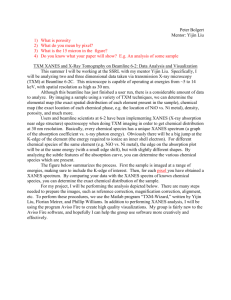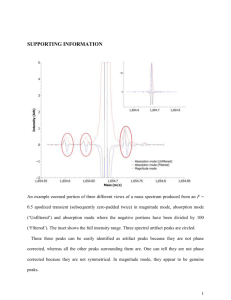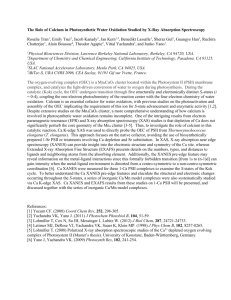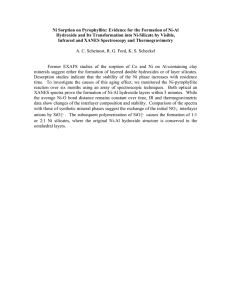Measurement of XANES Spectra of Biological Molecules K. Shinohara , A. Ito
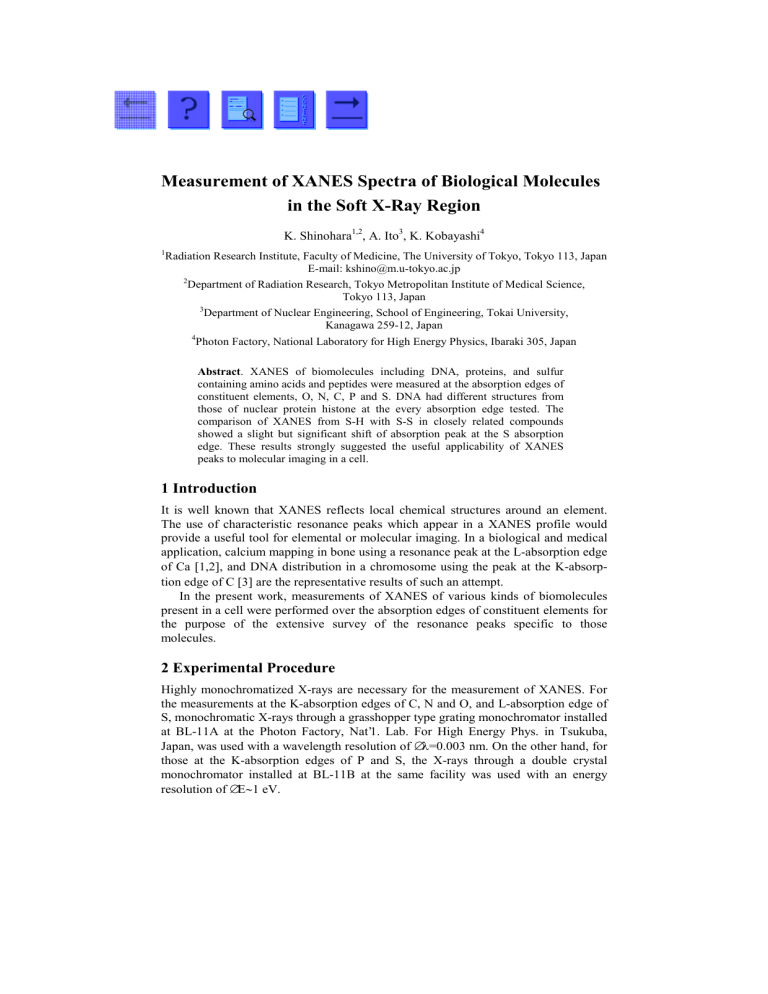
Measurement of XANES Spectra of Biological Molecules in the Soft X-Ray Region
K. Shinohara
1,2
, A. Ito
3
, K. Kobayashi
4
1
Radiation Research Institute, Faculty of Medicine, The University of Tokyo, Tokyo 113, Japan
E-mail: kshino@m.u-tokyo.ac.jp
2
Department of Radiation Research, Tokyo Metropolitan Institute of Medical Science,
Tokyo 113, Japan
3
Department of Nuclear Engineering, School of Engineering, Tokai University,
Kanagawa 259-12, Japan
4
Photon Factory, National Laboratory for High Energy Physics, Ibaraki 305, Japan
Abstract. XANES of biomolecules including DNA, proteins, and sulfur containing amino acids and peptides were measured at the absorption edges of constituent elements, O, N, C, P and S. DNA had different structures from those of nuclear protein histone at the every absorption edge tested. The comparison of XANES from S-H with S-S in closely related compounds showed a slight but significant shift of absorption peak at the S absorption edge. These results strongly suggested the useful applicability of XANES peaks to molecular imaging in a cell.
1 Introduction
It is well known that XANES reflects local chemical structures around an element.
The use of characteristic resonance peaks which appear in a XANES profile would provide a useful tool for elemental or molecular imaging. In a biological and medical application, calcium mapping in bone using a resonance peak at the L-absorption edge of Ca
[
1,2
]
, and DNA distribution in a chromosome using the peak at the K-absorption edge of C
[
3
]
are the representative results of such an attempt.
In the present work, measurements of XANES of various kinds of biomolecules present in a cell were performed over the absorption edges of constituent elements for the purpose of the extensive survey of the resonance peaks specific to those molecules.
2 Experimental Procedure
Highly monochromatized X-rays are necessary for the measurement of XANES. For the measurements at the K-absorption edges of C, N and O, and L-absorption edge of
S, monochromatic X-rays through a grasshopper type grating monochromator installed at BL-11A at the Photon Factory, Nat’1. Lab. For High Energy Phys. in Tsukuba,
Japan, was used with a wavelength resolution of
∆λ
=0.003 nm. On the other hand, for those at the K-absorption edges of P and S, the X-rays through a double crystal monochromator installed at BL-11B at the same facility was used with an energy resolution of
∆Ε∼
1 eV.
III - 158 K. Shinohara et al.
Monochromatic X-rays that transmit through 2 mm areas in the center of specimens were then detected by a silicon photodiode (AXUV-100, International
Radiation Detectors, Inc.) followed by a current measurement with a picoammeter.
The output of the picoammeter was collected into a computer via a V/F converter and a frequency counter in coincidence with wavelength scanning under a control of spectral measurement programs equipped at the beam lines.
Biological specimens include nucleic acid, proteins, sulfur-containing molecules.
A droplet of water solutions for these molecules was placed on a collodion membrane supported by an EM-grid and then dried to form a thin film. The specimens and their thickness were summarized in Table 1. Specimens for the measurements at the S and
P-K absorption edges should be much thicker than those at the C, N, O-K absorption edges and the S-L absorption edge because of higher transparency of analyzing Xrays. The thickness was estimated by the UV-absorption at the same area of the specimen as the area for XANES measurement. For the sulfur containing compounds which have no absorption in the UV and visible region, specimen thickness was not determined.
Table 1. Biological specimens and their thickness. Thickness of very thick specimens was estimated by the deposited amount of specimen solutions as shown in the fourth column
Specimen Thickness (µm)
Nucleic acid
Protein
DNA
Histone mixture
BSA
Cytochrome C
S compound Cysteine
Cystine
GSH
GSSG
Absorption edges of C, Absorption edges of P,
0.78
3.0
3.7
---
---
---
---
---
≈
9
≈
220
≈
120
---
---
---
---
---
Abbreviations: BSA: Bovine serum albumin, GSH: Glutathione (reduced form),
GSSG: Glutathione (oxidized form)
3 XANES Profiles of Biomolecules
3.1 DNA and Proteins
XANES of DNA was measured at the K absorption edge of P, and the K absorption edges of O, N and C. A prominent single resonance peak was observed at the P absorption edge as shown in Fig. 1. On the other hand, at the O, N and C absorption edges, the spectra exhibited more complex structures. These data were shown in the following three figures together with the spectra of a mixture of histones, major
Measurement of XANES Spectra of Biological Molecules III - 159
Fig. 1. XANES of DNA at phosphorus
K-absorption edge
Fig. 2. XANES of DNA and histone mixture at oxygen K-absorption edge nuclear proteins. At the O absorption edge (Fig. 2), two peaks would be probably assigned to 1s
→π
* transition of C= O bond and 1s
→σ
* transition of C-O bond in the increasing order of photon energy, from the results of an organic polymer, PMMA
(poly methyl methacrylate)
[
4
]
. Histone mixture had also resonance peaks at the same photon energies as DNA, although the ratio of the height of two peaks was largely different. Figure 3 shows XANES at N absorption edge.
π
* resonance absorption of
DNA was splitted into two peaks, in contrast to the single peak in histone mixture.
These
π
* peaks are probably due to the absorption of base part
[
5
]
. The use of these peaks, particularly the one of the lower photon energy which is not present in histone mixture seems very useful for the imaging of DNA in a nucleus where DNA was surrounded by nuclear proteins such as histones. At the C absorption edge DNA had several peaks (Fig. 4). The one at the lowest photon energy was attributed to the absorption of C=C bond according to Ade et. al.
[
3
]
, and subsequent three peaks probably due to C=N bond were also clearly resolved. The peak of C=C was found at the slightly lower energy compared with that of histone mixture, which was used to image DNA in a chromosome
[
3
]
. In addition, C=N peaks, unique to DNA, would be also available for such a purpose.
Fig. 3. XANES of DNA and histone mixture at nitrogen K-absorption edge
Fig. 4. XANES of DNA and histone mixture at carbon K-absorption edge
3.2 Sulfur Containing Molecules
Thiol (S-H) is a very reactive group playing various roles in cellular regulatory mechanisms such as regulation in a redox state by glutathione or cysteine and mainte-
III - 160 K. Shinohara et al.
nance of enzymatic or hormone activity as a protein thiol. The balance of thiol and its oxidized form disulfide (S-S), which is called thiol status, is also known to be critical in cellular responses when exposed to oxidative stress. In the present work, the following sulfur containing molecules were adopted for XANES measurement:
(1) cysteine (S-H), its oxidized form cystine (S-S) and methionine (S-C) as amino acids specimens; (2) glutathione (S-H) and its oxidized form (S-S) as peptide specimens; and (3) histone mixture, BSA and cytochrome C as protein specimens.
Figure 5 shows XANES of cysteine, cystine, and methionine at the S-K absorption edge. Slight shift toward the low photon energy of the absorption peak was noticed in the order of cysteine, methionine and cystine: Energy difference between the peaks of
S-H and S-C was about 0.25 eV, and that of S-C and S-S about 0.48 eV. The similar results were obtained in the case of GSH and GSSG (Fig. 6). The energy difference between S-H and S-S was the same as the case of amino acids in Fig. 5. In Fig. 6 mixture of GSH and GSSG (1:1) was also measured. A single peak was found to locate at the middle of the peaks of S-H and S-S, indicating that the present resolution was not enough to separate two peaks in the mixture. In addition, XANES of GSH and
GSSG at the L absorption edge of S also exhibited a similar peak shift as shown in
Fig. 7. These results clearly demonstrated that S-H and S-S could be discriminated by using absorption peaks in XANES, which further suggest the possibility to image these sulfur bondings in a cell.
Fig. 5. XANES of sulfur-containing amino acids at sulfur K-absorption edge
Fig. 6. XANES of glutathione at sulfur K-absorption edge
Fig. 7. XANES of glutathione at sulfur
L-absorption edge
Fig. 8. XANES of proteins at sulfur
K-absorption edge. Peak energies for BSA and histone mixture were shown as broken lines
Measurement of XANES Spectra of Biological Molecules III - 161
This conclusion was applied to the analysis of XANES of proteins (Fig. 8). In the
BSA spectrum a marked peak corresponding to S-S bond was evident compared with other two kinds of proteins. The result was in accord with the fact that almost all of
S-H groups in BSA form S-S bond.
4 Conclusions
1. XANES profiles of biomolecules were measured at the K-absorption edges of
C, N, O, S and P, and the L-absorption edge of S.
2. DNA had different XANES peaks around the C and N absorption edges from proteins, while at the O absorption edge the peaks located at the same photon energy. Probably C=N bond is responsible for these differences.
3. XANES profiles of S-H demonstrated the different absorption peak from those of
S-S.
4. Fraction of S-S reflected the peak height of S-S absorption in XANES at the wavelength region of the K-absorption edge.
5. For the purpose of the imaging of DNA in a nucleus, it may be suitable to choose the following XANES peaks: a single peak at the P-K absorption edge,
π
* peak at the N absorption edge and C=N peaks at the C absorption edge.
Acknowledgements
This work was performed under the approval of the Photon Factory Advisory
Committee (Proposal nos. 93G319, 95G283 and 95G284), and partly supported by a
Grant-in-Aid for Scientific Research (A) from the Ministry of Education, Science,
Sports and Culture.
References
1 J.M. Kenny, C. Jacobsen, J. Kirz, and H. Rarback, J. Microsc. 138, 321 (1985).
2 C.J. Buckley, Rev. Sci. Instrum. 66, 1318 (1995).
3 H. Ade, X. Zhang, S. Cameron, C. Costello, J. Kirz, and S. Williams, Science 258,
972 (1992).
4 N. Ueno, K. Kamiya, Y. Harada, M.C.K. Tinone, T. Sekitani, and K. Tanaka,
Optoelectronics 11, 91 (1996).
5 S.M. Kirtley, O.C. Mullins, J. Chen, J. van Elp, S.J. George, C.T. Chen,
T. O’Halloran, and S.P. Cramer, Biochim. Biophys. Acta 1132, 249 (1992).
